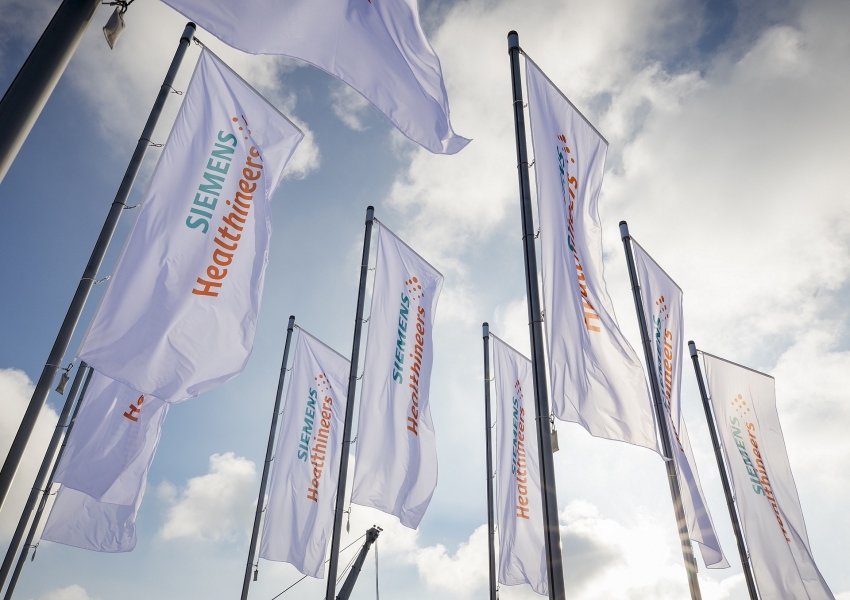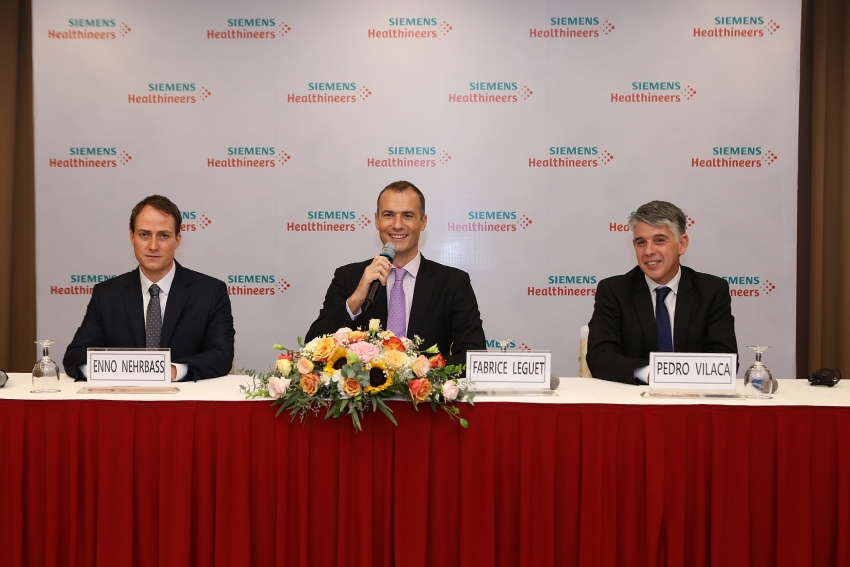AI: Transforming data into knowledge for better care
 |
| Siemens Healthineers uses AI to help healthcare providers around the world prepare for the trends affecting the sector |
Technology is opening up previously unimagined opportunities, thanks to exponential growth in computing power, huge memory capacity, and growth in networking. The key concept is artificial intelligence. Siemens Healthineers uses this technology to help healthcare providers around the world prepare for the trends affecting the sector and has a leading position in this area.
In addition, digitalising healthcare and combining the power of AI can help healthcare providers remain competitive despite the shortages of skilled staff and increasing imaging scan volumes. These technologies include digital twinning, AI Rad Companion Chest CT, and syngoVirtual Cockpit.
At Hospital Management Asia 2019, held in Hanoi, Vietnam, Siemens Healthineers focused on delivering high-value care by digitalising healthcare, while giving insights into its offerings in the area of AI.
Fabrice Leguet, Siemens Healthineers' president and managing director in Southeast Asia, explained, “Siemens Healthineers has more than 500 patents in machine learning, 125 patents in the area of deep learning, and more than 40 AI-based applications to pave the way for healthcare providers worldwide to expand precision medicine to foster individualised prevention and therapy with a precise diagnosis.”
The digital twin
For some time now, digital twins have been used in other industries, where they help to optimise processes in manufacturing, workflows, and machine modeling. Siemens Healthineers has now applied the concept of digital models to human organs and workflows.
Simulating organs or even the whole human body requires an AI-powered bio-physiological model. Such models require a tremendous amount of computing power, something that has only recently become widely available. Following on from initial research projects to create simulations of the human heart, other organs are now gradually being included on the path toward the vision of a digital twin of the entire human body.
The first organ to be precisely simulated using these methods was the heart. Based on MR images and ECG measurements, the model simulates the physiological processes of a patient’s most vital organ. Virtual planning can then be performed to visualise its responses to treatment on a computer before the actual intervention.
Siemens Healthineers is developing intelligent algorithms that generate digital models of organs based on vast amounts of data. Cardiologists tested the use of these algorithms in cardiac resynchronisation in a research project at the University of Heidelberg. The Heidelberg cardiologists created a digital twin of the patient’s heart, virtually implanted the electrodes, and virtually generated electrical pulses.
If the asynchronous pumping of the virtual heart was corrected, it served as an indication that resynchronisation therapy could also be successful in the real patient. This is an excellent example of using digitalisation and AI to help physicians develop more precise prognoses. Siemens Healthineers is pursuing an ambitious vision – that someday there will be digital twins of individual patients’ entire bodies.
In addition to the treatment of individual patients, digital twins could also help to optimise workflows, departments, or even entire organisations, such as hospitals. In a strategic partnership between Siemens Healthineers and the Medical University of South Carolina (MUSC), focusing on creating value, they plan to explore a range of options, including process optimisation using digital models of the hospital’s daily routine.
The goal is to offer patients the best possible care and, at the same time, set a new standard for other hospitals. Several scenarios can be simulated as digital twins and their effects on process efficiency represented without incurring major costs.
 |
| Fabrice Leguet, Siemens Healthineers' president and managing director in South East Asia, spoke at the event |
AI RAD Companion Chest CT
AI-Rad Companion Chest CT is a software assistant that brings AI to computed tomography (CT). Teams of Siemens Healthineers scientists trained the underlying algorithms based on extensive clinical datasets. Using CT images of the thorax (chest), the software can differentiate between the various structures of the chest, highlight them individually and mark and measure potential abnormalities.
This applies equally to organs such as the heart and lungs, the aorta, and the vertebral bodies. The software automatically turns the findings into a quantitative report.
CT examinations of the thorax are common procedures in daily clinical practice. In radiology, examinations of the chest, a region containing multiple organs, are also challenging because the images display a wide variety of information. Radiologists mainly assess images regarding the primary indication – in other words, the possible disease – which was the reason for performing the CT scan.
By contrast, the algorithms in AI-Rad Companion Chest CT pay equal attention to all areas of the chest and can mark abnormalities in places that the radiologist might not consider so closely. The software assistant generates standardised, reproducible, and quantitative reports based on the AI-supported analysis.
AI-Rad Companion Chest CT also examines the spine in the patient’s chest region. It detects and segments the individual vertebrae, labels and analyses them for bone density and possible fractures. This can be helpful for detecting osteoporotic changes at an early stage.
syngoVirtual Cockpit
Many healthcare markets suffer personnel shortages or bottlenecks for various reasons. Amongst others, not all hospital or practice locations will have the appropriate experts on hand for scanning patients with complex medical questions. syngoVirtual Cockpit can help ease a tight human resource situation and improve productivity at the facility. Medical staff can use this software solution to connect remotely to scanner workplaces to assist personnel at a different location, especially where more sophisticated examinations are required.
With the ability to deploy experienced technologists across multiple locations, healthcare providers can transform care delivery and achieve a higher level of standardisation that leads to more accurate diagnoses.
For radiological examinations, experienced colleagues can “tune in” quickly and in real time via headsets, conference speakers, or chat or video functions. That means the experts can remain in their own location and provide guidance for the colleagues operating the scanner at the other locations, e.g. to adjust protocol parameters.
The software solution is also suitable for training purposes, since having a trainer in the background can help operators learn how to perform complex examinations like cardiac MRI in a practical situation. In other words, syngoVirtual Cockpit can enable all technologists to benefit from the experience of the experts in the team.
With increasing volumes and complexity of data from different sources and across a range of disciplines, AI is the key to make medical technology smarter, analyse image data and lab results faster, and make examinations more accurate.
“AI enables more personalised healthcare with precision medicine along the entire continuum of care: identification of high-risk patients, prevention of unnecessary treatments, high-quality diagnostics and more accurate and targeted treatments. In the future, Siemens Healthineers will expand its role as a reliable partner for entering the world of AI in a medical context,” added Enno Nehrbass, Siemens Healthineers' head of strategy and digital services in Asia Pacific.
What the stars mean:
★ Poor ★ ★ Promising ★★★ Good ★★★★ Very good ★★★★★ Exceptional
 Tag:
Tag:
Related Contents
Latest News
More News
- Vietnam’s industrial output hits seven-year high in 2025 (January 06, 2026 | 17:47)
- GELEX’s credit rating outlook upgraded to 'Positive' by VIS Rating (January 06, 2026 | 16:49)
- Finance sector lays firm groundwork for 2026 after major reform (January 06, 2026 | 15:30)
- Vietnam’s seafood exports surpass $11 billion in 2025 (January 06, 2026 | 08:51)
- Vietnam GDP posts second-strongest growth since 2011 (January 06, 2026 | 08:35)
- Double-digit GDP growth within reach with shift to higher-value expansion (January 06, 2026 | 08:33)
- Takeda Vietnam awarded for ongoing support of Vietnam’s sustainability efforts (December 31, 2025 | 21:00)
- Vietnam's retail market tops $269 billion in 2025 amid e-commerce boom (December 31, 2025 | 19:00)
- Stronger legal framework urged as trade fraud surges online (December 31, 2025 | 18:58)
- FPT exports first chip shipment to Japan (December 31, 2025 | 10:47)
























 Mobile Version
Mobile Version